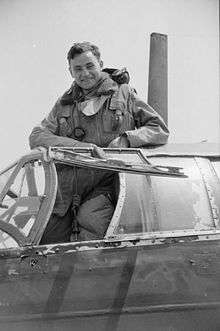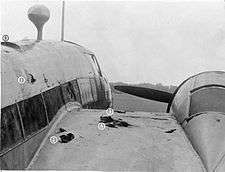James Allen Ward
| James Allen Ward VC | |
|---|---|
 Sergeant James Allen Ward standing in the cockpit of his Vickers Wellington Mark IC, L7818 'AA-V', at Feltwell, Norfolk, July 1941 | |
| Born |
14 June 1919 Wanganui, New Zealand |
| Died |
15 September 1941 (aged 22) over Hamburg, Germany |
| Buried at | Commonwealth War Grave Cemetery Ohlsdorf, Hamburg |
| Allegiance |
|
| Service/branch |
|
| Years of service | 1940–1941 |
| Rank | Sergeant Pilot |
| Unit | No. 75 (NZ) Squadron |
| Battles/wars | Second World War |
| Awards |
|
James Allen Ward VC (14 June 1919 – 15 September 1941) was a New Zealand recipient of the Victoria Cross, the highest and most prestigious award for gallantry in the face of the enemy that can be awarded to British and Commonwealth forces.
Biography
Ward was born in Wanganui, where he attended Wanganui Technical College. He trained as a teacher at the Wellington College of Education in 1938, and taught until enlisting in the Royal New Zealand Air Force (RNZAF) on 2 July 1940. He trained as a pilot at Taieri and Wigram with Fraser Barron, who went on to become a renowned bomber pilot during the war. Barron and Ward sailed together on the Aorangi in January 1941 and were both stationed at 20 OTU Lossiemouth, in Scotland.[1]
Engine fire and Victoria Cross award
Ward was a 22-year-old sergeant pilot with No. 75 (NZ) Squadron when he carried out the action for which he was awarded the Victoria Cross (VC). He was co-pilot on a Vickers Wellington bomber flying out of RAF Feltwell in Norfolk, United Kingdom. On 7 July 1941 after an attack on Münster, Germany, the Wellington (AA-R) in which Sergeant Ward was second pilot was attacked by a German Bf 110 night fighter. The attack opened a fuel tank in the starboard wing and caused a fire at the rear of the starboard engine.

The skipper of the aircraft told him to try to put out the fire. Sergeant Ward crawled out through the narrow astrodome (used for celestial navigation) on the end of a rope initially reported as being taken from the aircraft's emergency dinghy, but actually from an engine cover. He kicked or tore holes in the aircraft's fabric with a fire axe to give himself hand- and foot-holes. By this means he reached the engine and attempted to smother the flames with a canvas cover.
Although the fuel continued to leak, with the fire out the plane was now safe. His crawl back over the wing, in which he had previously torn holes, was more dangerous than the outward journey but he managed with the help of the aircraft's navigator. Instead of the crew having to bail out, the aircraft made an emergency landing at Newmarket, United Kingdom.
The recommendation for a VC was a matter of discussion at the time. Senior RAF officers questioned whether a VC was appropriate, since his actions had some aspect of self-preservation.
In the summer of 1941, Sergeant Ward was summoned to 10 Downing Street by Prime Minister Winston Churchill. The shy New Zealander was struck dumb with awe by the experience and was unable to answer the Prime Minister's questions. Churchill regarded the reluctant hero with some compassion. "You must feel very humble and awkward in my presence," he said. "Yes, sir," managed Ward. "Then you can imagine how humble and awkward I feel in yours," said Churchill. However, there is some doubt about the accuracy of this anecdote as Churchill was aboard HMS Prince of Wales meeting the US President at the time it is reported to have happened.[2]
Victoria Cross citation
The announcement and accompanying citation for the decoration was published in supplement to the London Gazette on 5 August 1941, reading
Air Ministry, 5 August 1941The KING has been graciously pleased to confer the VICTORIA CROSS on the undermentioned non-commissioned officer in recognition of most conspicuous bravery :-
NZ401793 Sergeant Pilot James Allen Ward
On the night of 7 July 1941, Sergeant Ward was second pilot of a Wellington bomber returning from an attack on Munster. While flying over the Zuider Zee at 13,000 feet his aircraft was attacked from beneath by a German ME110, which secured hits with cannon-shell and incendiary bullets. The rear gunner was wounded in the foot but delivered a burst of fire sending the enemy fighter down, apparently out of control. Fire then broke out in the Wellington's near-starboard engine and, fed by petrol from a split pipe, quickly gained an alarming hold and threatened to spread to the entire wing. The crew forced a hole in the fuselage and made strenuous efforts to reduce the fire with extinguishers, and even coffee from their flasks, without success. They were then warned to be ready to abandon the aircraft. As a last resort Sergeant Ward volunteered to make an attempt to smother the fire with an engine cover which happened to be in use as a cushion. At first he proposed discarding his parachute to reduce wind resistance, but was finally persuaded to take it. A rope from the aircraft dingy was tied to him, though this was of little help and might have become a danger had he been blown off the aircraft.
With the help of his navigator he then climbed through the narrow astrodome and put on his parachute. The bomber was flying at a reduced speed but the wind pressure must have been sufficient to render the operation one of extreme difficulty. Breaking the fabric to make hand and foot holds where necessary and also taking advantage of existing holes in the fabric, Sergeant Ward succeeded in descending three feet to the wing and proceeding another three feet to a position behind the engine, despite the slipstream from the airscrew which nearly blew him off the wing. Lying in this precarious position he smothered the fire in the wing fabric and tried to push the engine cover into the hole in the wing and on the leaking pipe from which the fire came. As soon as he had removed his hand, however, a terrific wind blew the cover out and when he tried again it was lost. Tired as he was, he was able, with the navigator's assistance, to make a successful but perilous journey back into the aircraft. There was now no danger of fire spreading from the petrol pipe as there was no fabric left near it and in due course it burned itself out. When the aircraft was nearly home, some petrol which had collected in the wing blazed up furiously but died down quite suddenly. A safe landing was made despite the damage sustained to the aircraft. The flight home had been made possible by the gallantry of Sergeant Ward in extinguishing the fire on the wing in circumstances of the greatest difficulty and at the risk of his life. [3]
When the war ended and the Allies gained access to Luftwaffe intelligence reports of Night fighter interceptions it was found that no German aircraft reported being in combat with the Wellington and the identity of its attacker remains a mystery.
Death and legacy
James Ward was killed in action on 15 September 1941, when his Wellington bomber was hit by flak over Hamburg, caught fire and crashed.[4] Only two of the five crew survived. It was Ward's 11th sortie, and his 5th as crew captain. He is buried in the Commonwealth War Grave Cemetery Ohlsdorf in Hamburg.
The Victoria Cross was presented to his parents, Mr and Mrs P. H. Ward, by the Governor General of New Zealand at Government House, Wellington on 16 October 1942. On 3 March 2006, Ward's VC and other service medals, which previously had been in the custody of the RNZAF, were returned to his family, who have since permanently lent them to the Auckland War Memorial Museum for display in the armoury section. A wooden model aircraft Ward was making when he was called up is on display at the RNZAF Museum.
On 18 November 2004, shortly before the dissolution of the Wellington College of Education,[5] in preparation for merging with Victoria University, the hall at the complex was renamed[6] the Ward VC Hall. Today it is incorrectly called the Alan Ward VC Hall.[7]) The assembly hall at Ward's alma mater, Wanganui City College (formerly Wanganui Technical College), is also named after him.
On 14 May 2011, the community centre at RAF Feltwell was dedicated in his honour.
References
- ↑ Lambert, Max (2005, pp. 184–187). Night After Night: New Zealanders in Bomber Command. Published by Harper Collins, Auckland. OCLC 238569316. ISBN 1-86950-542-5.
- ↑ C. Fadiman, The Little, Brown Book of Anecdotes, p.122 (1985)
- ↑ The London Gazette: no. 35238. p. 4515. 5 August 1941. Retrieved 17 July 2015.
- ↑ "James Allen Ward Vc". Victoriacross.org.uk. Retrieved 2015-10-05.
- ↑ Archived 5 February 2012 at the Wayback Machine.
- ↑ Archived 24 July 2011 at the Wayback Machine.
- ↑ Archived 11 October 2006 at the Wayback Machine.
External links
| Wikimedia Commons has media related to James Allen Ward. |
- Sergeant J.A. Ward in The Art of War exhibition at the UK National Archives
- Ward J.A.
- New Zealand Troops who have won the Victoria Cross at the Wayback Machine (archived 26 October 2009) (brief biography details)
- Photograph of the wing of Ward's Wellington showing the hand and foot-holds made in the fabric covering
- Pathe News film of Ward